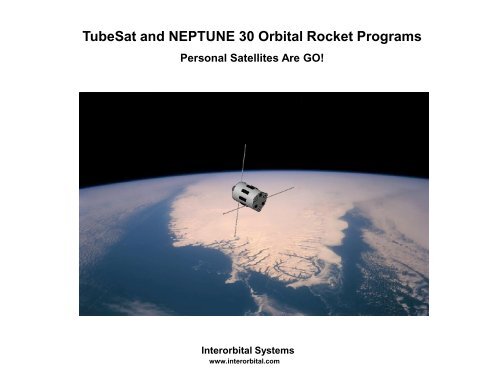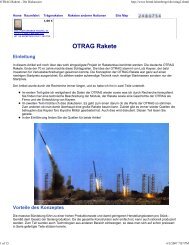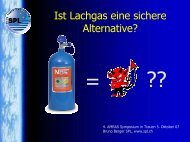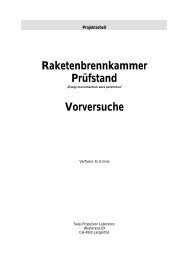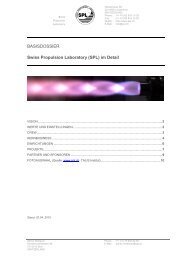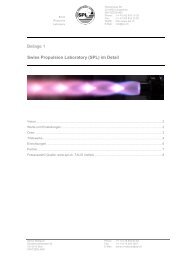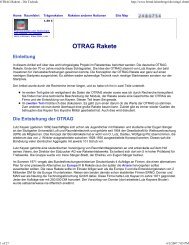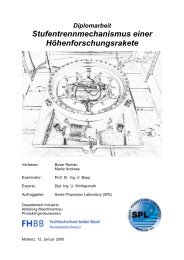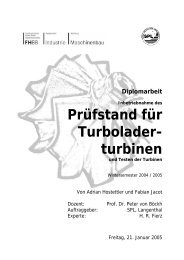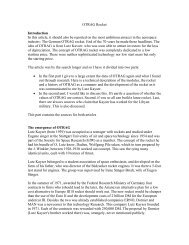Sun_1320_TubeSat Utah August 2009 1.pdf - This machine hosts ...
Sun_1320_TubeSat Utah August 2009 1.pdf - This machine hosts ...
Sun_1320_TubeSat Utah August 2009 1.pdf - This machine hosts ...
- No tags were found...
Create successful ePaper yourself
Turn your PDF publications into a flip-book with our unique Google optimized e-Paper software.
<strong>TubeSat</strong> and NEPTUNE 30 Orbital Rocket ProgramsPersonal Satellites Are GO!Interorbital Systemswww.interorbital.com
About InterorbitalCorporationFounded in 1996 by Randa and Roderick Milliron, incorporated in 2001Located at the Mojave Spaceport in Mojave, California98.5% owned by R. and R. Milliron1.5% owned by Eric GullichsenInitial Starting TechnologyPressure-fed liquid rocket enginesInitial MissionLow-cost orbital and interplanetary launch vehicle developmentFacilities6,000 square-foot research and development facilityTwo rocket engine test sites at the Mojave SpaceportExpert engineering and manufacturing teamInterorbital Systemswww.interorbital.com
Core Technical TeamRoderick Milliron:Chief DesignerLutz Kayser:Primary Technical ConsultantEric Gullichsen:Guidance and ControlGerard Auvray:Telecommunications EngineerDonald P. Bennett: Mechanical EngineerDavid Silsbee:Electronics EngineerJoel Kegel:Manufacturing/Engineering TechJacqueline Wein:Manufacturing/Engineering TechReinhold Ziegler:Space-Based Power SystemsE. Mark Shusterman,M.D. Medical Life SupportRanda Milliron:High-Temperature CompositesInterorbital Systemswww.interorbital.com
Key Hardware Built In-HousePropellant Tanks: Combining state-of-the-art composite technologywith off-the-shelf aluminum linersAdvanced Guidance Hardware and SoftwareAblative Rocket Engines and ComponentsGPRE 0.5KNFA Rocket Engine TestManned Space Flight Training SystemsRocket Injectors, Valves Systems, and Other Metal componentsInterorbital Systemswww.interorbital.com
Project HistoryPressure-Fed Rocket EnginesGPRE 2.5KLMA Liquid Oxygen/Methanol Engine: Thrust = 2,500 lbs.GPRE 0.5KNFA WFNA/Furfuryl Alcohol (hypergolic): Thrust = 500 lbs.GPRE 0.5KNHXA WFNA/Turpentine (hypergolic): Thrust = 500 lbs.GPRE 3.0KNFA WFNA/Furfuryl Alcohol (hypergolic): Thrust = 3,000 lbs.GPRE 10.0KNHXA WFNA/Turpentine (Hypergolic): Thrust = 10,000 lbs.Pressure-Fed Sounding RocketsNeutrino: GPRE 0.5NFA EngineTachyon: GPRE 3.0KNHXA EngineManned SystemsDick Rutan’s Global Hilton ProjectHelium/Hot Air Balloon System Propane TanksInterorbital Systemswww.interorbital.com
Present MissionNEPTUNE Modular Series Orbital Launch VehiclesNEPTUNE 30 (30 kg to LEO)NEPTUNE 1000 (1000 kg to LEO)NEPTUNE 4000 (4000 kg to LEO)Orbital SpacecraftOrbital Expedition Crew Modules (6-person capacity)Robotic Orbital Supply System (ROSS)Interplanetary SpacecraftGoogle Lunar X PRIZE Lunar LanderRobotic InterPlanetary Prospector Excavator Retriever (RIPPER)Satellite Design and Manufacture<strong>TubeSat</strong>Interorbital Systemswww.interorbital.com
IOS Unique Satellite TechnologiesLow-Cost Pico Satellite Kit – The <strong>TubeSat</strong>Satellite casing and satellite ejection system are constructed from off-the-shelf aluminum tubingManufacturing requires minimal machiningMakes use of the latest developments in off-the-shelf electronicsMakes use of highly efficient solar cells (26% efficiency)Simple satellite ejection system allows <strong>TubeSat</strong>s to be launched one at a time or in groups of 32Each <strong>TubeSat</strong> never comes in contact with other <strong>TubeSat</strong>s in a launch groupLow-Cost Dedicated Launch Vehicle – NEPTUNE 30All <strong>TubeSat</strong>s have primary payload statusInterorbital Systemswww.interorbital.com
<strong>TubeSat</strong> DescriptionThe new IOS <strong>TubeSat</strong> Personal Satellite Kit is a low-cost alternative to the CubeSatIt has three-quarters of the weight and volume of a CubeSat (weight = 0.75 kg or 1.65 lbs)Still offers plenty of space for most experiments or applicationsThe price of the <strong>TubeSat</strong> Kit ($8,000) includes the price of a launch into Low-Earth-Orbit on an IOS NEPTUNE30 rocketSince <strong>TubeSat</strong>s are placed into self-decaying orbits (310 km), they do not contribute to the long-term buildup oforbital debrisAfter a few weeks of operation, they re-enter the atmosphere and burn-upLaunches are expected to begin in the fourth quarter of 2010Interorbital Systemswww.interorbital.com
<strong>TubeSat</strong> ComponentsGeneral DescriptionCylinder shapedMaximum weight: 0.75 kgSatellite bus or stand-alone satellitePowerBatteries: lithium ion 3.6 VSolar Cells: Spectrolab 2.52 V 31 mA (multiples)Power management boardTransceiver Options:Microhard n425, n920, or n2420Frequency range: 400 to 450 MHz902 to 928 MHz or2.4000 to 2.4835 GHzVoltage: 3.3VDCOutput: 100 mW to 1,000 mW SelectableMicrocomputer HardwareBasicX-24pRogue Robotics uMMC serial Data ModuleAntennasDipoleInterorbital Systemswww.interorbital.com
Interorbital Systemswww.interorbital.com<strong>TubeSat</strong> Component Layout
Interorbital Systemswww.interorbital.com<strong>TubeSat</strong> Deployment System
<strong>TubeSat</strong> ApplicationsEarth-from-space video imagingEarth magnetic field measurementSatellite orientation detection (horizon sensor, gyros, accelerometers, etc.)Amateur radio relayOrbital environment measurements (temperature, pressure, radiation, etc.)On-orbit hardware and software component testing (microprocessors, etc.)Tracking migratory animals from orbitTesting satellite stabilization methodsBiological experimentationAutomatic simple, repeating “message from orbit” transmissionPrivate e-mailThe builder can add any type of electronics or software application he or she wishes aslong as it satisfies the volume and mass restrictions. These restrictions provide aunique intellectual challenge for the application designer.Interorbital Systemswww.interorbital.com
Customer SupportCall-in or e-mail tech support (Interorbital and/or University partners)Dedicated support page at www.tubesat.org (coming soon)On-line password-accessed users’ forumsConstantly updated FAQsQuarterly (or more frequent) user’s workshops on-ground or on-lineDocumentation: NEPTUNE 30 Rocket User’s Manual<strong>TubeSat</strong> Kit User’s ManualInterorbital Systemswww.interorbital.com
NEPTUNE 30: The <strong>TubeSat</strong> Launch VehicleInterorbital Systemswww.interorbital.com
IOS Unique Launch Vehicle TechnologiesEnvironmentally Safe, Storable, High-Density Hypergolic PropellantsWhite Fuming Nitric Acid (WFNA) and Turpentine/Furfuryl AlcoholInstantaneous chemical ignition eliminates need for complex ignition systemLow-Cost Propellant Tank TechnologyOff-the-shelf aluminum tank liners and tank endsState-of-the-art composite tank reinforcement technologyBlowdown Propellant FeedEliminates the need for turbopumps or a separate pressurant systemUnique Rocket Engine InjectorAutomatically maintains propellant jet flow rate in blowdown modeMaximizes specific impulse over a wide pressure input rangeDifferential Throttling Rocket Steering TechnologyAllows all rocket engines to be fixedEliminates complex gimballing or fluid injection steering systemsThere are no steering penalties such as jet-vane drag lossRockets with throttleable engines don’t require hold downsModular Rocket System – The Common Propulsion Module (CPM)Only small rocket engines have to be developedSmall rocket engines cost less to developSmall diameter tanks don’t require slosh bafflesIndividual rocket modules can be flight tested at a very low costLaunch vehicle can be customized for any payloadInterorbital Systemswww.interorbital.com
IOS Rocket Technology: Common Propulsion ModuleThe Common Propulsion Module (CPM) is the Basic Building Block of all Neptune Modular Series Rockets.The CPMs can be clustered together in multiples for both small and large orbital and interplanetary payloads.Clustered engines have been in use since the beginning of the race for space. Below is an aft view of theRussian Soyuz rocket with a cluster of 32 engines. The Soyuz rocket is the most reliable rocket in the world.NEPTUNE 30 NEPTUNE 1000 NEPTUNE 4000Interorbital Systemswww.interorbital.com
Neptune 30 Modular System3 stages31 feet (9.4 m) in length with a maximum width of 6.2 feet (1.89 m)The GLOW is 18,700 pounds (8,841 kg)Five (5) Common Propulsion ModulesSatellite Module has a solid kick motor (Thrust = 1,500 lbs.)Booster Thrust = 4 X 10,000 lbs = 40,000 Lbs SL (177,920 n)Interorbital Systemswww.interorbital.com
Nitric Acid: Von Braun’s Oxidizer of ChoiceLutz Kayser: OTRAG and Rod Milliron: InterorbitalHypergolicWernher von Braun: NASA, OTRAGLutz Kayser: OTRAGInterorbital Systemswww.interorbital.com
NEPTUNE 30: Pressure-Fed PropellantsHigh-density (1.51) storable oxidizer: White Fuming Nitric Acid (WFNA)Storable fuels: Turpentine and Furfuryl AlcoholWFNA is corrosive but non-flammable and non-toxicLong-term Storage possible in the propellant tanksTurpentine furfuryl alcohol are are denser than keroseneInsulated storage tanks not requiredOrbital launch vehicle history (Diamant A rocket)Saphir with Emeraude Booster StageThe pressure-fed Diamant Arocket succeeded in placinga satellite into orbit on its firsttry in November of 1965Excerpt of a CPM Booster rocket enginetest (expansion to ambient) at IOS AlphaTest SiteInterorbital Systemswww.interorbital.com
NEPTUNE 30 SuccessesRocket engine system components have already been successfully testedPropellant tank components have been successfully testedGuidance and Control System has been successfully bench testedTest infrastructure is already in place (vertical test stand and test site hardware)Propellant and COTS component suppliers have been identifiedLaunch site secured on an island in the South Pacific Kingdom of TongaDesign and manufacturing team is already in placeNo existing competition at this price, value, launch frequency, orperformance levelInterorbital Systemswww.interorbital.com
NEPTUNE 30 Test ProgramGround SystemsGround transport systemLaunch platformRocket lift systemPropellant loading systemLaunch control systemGround communications systemRocket Communication SystemsTransceiversAntennasGeneral Launch ProcedureRocket HardwareRocket engine/motor performance in flightReaction control systemRocket engine throttling systemRocket structural characteristics in flightRocket stability in flightGrid-fin effectiveness criteria in flightPayload ejection systemRecovery systemRocket staging systemSpin stabilizationGuidance and ControlInertial measurement unitGuidance computerGuidance softwareInterorbital Systemswww.interorbital.com
Flight Test Program (CPM)Common Propulsion Module (CPM) Flight TestsLaunch 1:Location: Mojave Test AreaRocket: Common Propulsion ModuleAltitude: 50,000 feet (15.3 km)Payload: <strong>TubeSat</strong>s and <strong>TubeSat</strong> deployment system or otherPurpose: Test systems described under Neptune 30 Test ProgramTime Frame: Jan/Feb 2010Launch 2:Location: Mojave Test AreaRocket: Common Propulsion ModuleAltitude: 50,000 feet (15.3 km)Payload: <strong>TubeSat</strong>s and <strong>TubeSat</strong> deployment system or otherPurpose: Test systems described under Neptune 30Test Programwith modifications if requiredTime Frame: April/May 2010Launch 3:Location: Mojave Test AreaRocket: Satellite Module with solid rocket motorAltitude: 20,000 feet (6.1 km)Payload: <strong>TubeSat</strong>s and <strong>TubeSat</strong> deployment system or otherPurpose: Test spin stabilization systemTime Frame: June 2010Interorbital Systemswww.interorbital.com
Flight Test Program (NEPTUNE 30)NEPTUNE 30 Flight TestsLaunch 1:Location: Mojave Test Area or Delamar Dry LakeRocket: NEPTUNE 30 with dummy core stage and Satellite ModuleAltitude: 50,000 feet (15.3 km)Payload: <strong>TubeSat</strong>s and <strong>TubeSat</strong> deployment system or otherPurpose: Test systems described under Neptune 30 Test ProgramTest Satellite Module spin-up and deployment system (with recovery)Test differential thrust steering systemTest rocket stability at Mach 1 and at maximum dynamic pressureTest staging systemTime Frame: <strong>August</strong>/September 2010Launch 2:Location: Tonga SpaceportRocket: NEPTUNE 30Altitude: 312 km (193.3 mi)Payload: 32 <strong>TubeSat</strong>s and <strong>TubeSat</strong> deployment system or otherPurpose: First orbital satellite launchTime Frame: November/December 2010Interorbital Systemswww.interorbital.com
Flight Test Payload OptionsCommon Propulsion Module, Satellite Module, or Staging TestMaximum Payload: 30 kgPayload Type:Up to 32 <strong>TubeSat</strong>sUp to 15 CubeSatsSingle PayloadCPM test vehicle is recoverableOrbital LaunchMaximum Payload:Payload Type:30 kgUp to 32 <strong>TubeSat</strong>sUp to 15 CubeSats with 5 P-PodsSingle satellite with deployment systemInterorbital Systemswww.interorbital.com
Interorbital Systemswww.interorbital.comNEPTUNE 30: Launch Scenario
Launch Licenses & PermitsFAA/AST launch license for orbital launches: in processIOS held one of the first Commercial Space Transportation Launch Licenses (LLS 00-054,October, 2000) for Tachyon sounding rocketObtained: Two active 365-day FAA waivers for pre-orbital flight tests to 50,000 ft. at Mojave TestArea, California, and at Delamar Dry Lake, NevadaInterorbital Systemswww.interorbital.com
IOS' Tongan SpaceportKingdom of TongaLatitude: 21.45 degrees SLongitude: 174.90 degrees WInterorbital Systemswww.interorbital.com
NEPTUNE 1000: Moon RocketInterorbital Systemswww.interorbital.com
WWW.INTERORBITAL.COM


